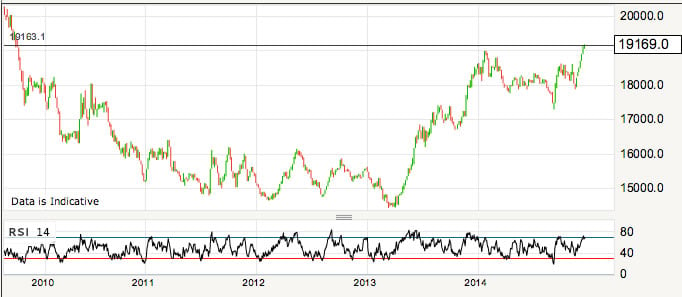GBP Tests Best Rate Since 2009 vs Australian Dollar
We are seeing some of the best rates in GBP-AUD since 2010 at the present time thanks to the growing realisation that the Australian currency is overvalued.
The pound to Australian dollar exchange rate (GBP/AUD) is currently seen at 1.8700 - just off the December 2014 highs located at around 1.9169.
As the below image shows resistance at 1.90 appears to have held back the GBP - we await the current consolidation phase at current levels to continue ahead of a fresh push higher.
Note: The above quotations are from the wholesale markets - a retail rate will be subject to a discretionary spread charged by your bank. To get as close to the market as possible use an independent FX provider - they are able to deliver up to 5% more FX through tighter exchange rates and market-beating strategies.
Why the Outlook for the Aussie Dollar has Deteriorated
We no longer expect the RBA to raise rates in 2015 while the US Federal Reserve and perhaps the Bank of England will start lifting rates which sees the yield advantage on Australian debt decline.
"This view implies a weaker profile for the AUD next year. We now expect the Australian dollar to end next year at US$0.7500," says a note from St. George Bank.
The US Federal Reserve remains on track to begin normalising monetary policy next year, which should continue to give the USD a boost.
"An RBA on hold next year, ongoing USD strength and renewed weakness in the prices of Australia’s key commodities suggests the risks are to the downside for the AUD/USD next year," say St. George.
As commodities drop, the value of currencies from Australia, New Zealand and Canada also fall, "which leaves the Aussie and its dollar-bloc rivals vulnerable to further losses," says Esiner.
NZ Dollar Slumps, Drags Down its Aussie Neighbour
Sentiment towards the antipodean dollars is extremely negative at present. We saw the pair move in tandem through the closing stages of 2014 and they are unwilling to decouple at this stage it would seem.
"The New Zealand dollar tumbled hard on the first trading day of the week, dropping more than 150 points off its opening highs after the RBNZ revealed that it had intervened in the currency market in August to the tune of 521 million NZD," says Boris Schlossberg at BK Asset Management.
The news took the market by surprise as currency traders assumed that the RBN was only engaged in verbal intervention up to now. "The figure was above the 500M threshold considered to be significant by the market and therefore had an immediate negative impact on the NZD/USD exchange rate which slid to a low of 7706 in Asian session trade before rebounding slightly in European dealing," says Schlossberg.
Outlook for the Aus Dollar: Best Exchange Rates of 2014
Can the uptrend in the pound to Australian dollar rate continue?
"The RBA considering macro-prudential measures to take the steam out of the housing market is an outright negative for the AUD, in our view. Indeed, the RBA’s Edwards this week used an interview with the Nikkei to suggest that the AUD has further room to fall," says Morgan Stanley in an exchange rate outlook note.
But, beware, the GBP faces some risks at the start of the new month.
The beginning of a new month brings with it the latest PMI data series which sterling is particularly sensitive to.
Essentially markets will looking for data to at least equal expectations - if so this will keep the expectation for Bank of England interest rate rises at the start of 2015 alive.
"Some political uncertainty has also started to build in the UK and so could pose a risk going into the elections next year. We will be watching the PMI releases in particular this week," say Morgan Stanley.
Currency Market Review
The following review comes courtesy of Guardian Stockbrokers in London:
- The EUR ended the week lower against the USD this past week amid a slowdown in manufacturing activity in the Eurozone and Germany in September. Meanwhile, the EUR lost further support after ECB Chief Mario Draghi reiterated his stance of further unconventional measures if the region continued to encounter a prolonged period of low inflation.
- The GBP fell against the dollar during the week. Meanwhile, the Bank of England Governor Mark Carney signalled that the timing to raise benchmark lending rates in the UK is coming closer as the economic outlook of the nation has improved.
- The USD ended mostly higher against most major currencies last week following hawkish comments from few Federal Reserve officials. The USD was further boosted after economic growth in the US expanded at its quickest pace in almost 3 years last quarter.
- The GBP weakened 0.2% against the USD to finish at 1.6250, while the EUR slipped 1.1% against the USD to close at 1.2684.





